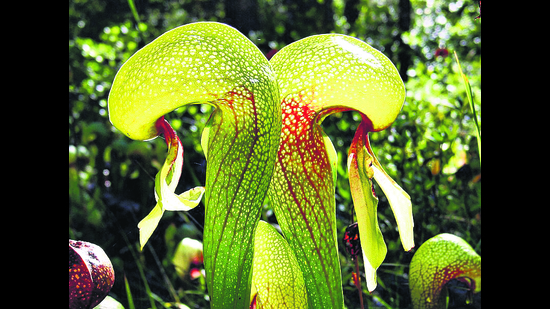Nature’s creativity knows no bounds, and nowhere is this more evident than in the world of flowers. Some are delicate and beautiful, while others appear to be straight out of a horror movie—parasitic vines that burst forth like alien invaders, ghostly white blooms that thrive in darkness, and carnivorous plants that consume unsuspecting insects. Among the 400,000 known species of flowers, a handful stand out for their bizarre and fascinating characteristics. Let’s explore some of the world’s strangest floral wonders.
The Ancient Mystery: Montsechia vidalii
The oldest known flower on Earth, Montsechia vidalii, was unlike any bloom we recognize today. Thriving in Europe’s lakes during the Cretaceous period, approximately 130 million years ago, it had no petals, no nectar-producing structures, and more closely resembled a weed than a flower. Fossils discovered in Spain in 2015 confirmed that its main function was to bear fruit, each bud containing a tiny seed.
A Key to the Future: Dicliptera polymorpha
Discovered just five years ago in the Talegaon-Dabhade grasslands of Maharashtra, India, Dicliptera polymorpha is a plant that thrives in fire. Similar species have been found in Africa, suggesting a link between the Indian subcontinent and Africa’s ancient landscapes. This fire-dependent plant blooms in response to wildfires, using the high summer temperatures—sometimes reaching 60°C—to trigger its growth. Scientists believe studying such plants could offer insights into climate-resilient traits.
Confuse and Consume: Darlingtonia californica
Also known as the California pitcher plant, Darlingtonia californica is a carnivorous predator that lures insects with its sugary scent. Bugs expecting a sweet reward instead find themselves trapped in a maze of translucent openings. A single slip leads them down a slippery inner wall lined with downward-pointing hairs, forcing them into a pool of digestive fluids. Once native to the forests of Northern California and Oregon, this nightmare-inducing plant thrives near bogs and creeks.
The Ghost That Blooms: Monotropa uniflora
This eerie, parasitic plant grows 2 to 12 inches above the ground, bearing translucent white flowers that give it the common name ghost pipe. Found in the forests of Asia, North America, and northern South America, it lacks chlorophyll and depends on fungi for sustenance. Among the Cherokee people, its bowed white blossoms symbolize humility and friendship, believed to grow wherever friends have quarreled.
The Corpse Flower: Rafflesia
Like a scene from a horror movie, Rafflesia begins its life as an invisible parasite, growing within a tropical vine. Eventually, it erupts into giant, cabbage-like buds, unfolding into massive, foul-smelling flowers—some reaching up to three feet in diameter. Indigenous tribes in Southeast Asia have used Rafflesia in traditional medicine for centuries, but habitat destruction threatens its survival. A 2023 study led by Oxford University’s Botanic Garden found that 67% of the 42 known Rafflesia species grow in unprotected regions, putting them at risk of extinction.
India’s Hidden Horror: Sapria himalayana Griffith
One of India’s rarest flowers, Sapria himalayana—also called the Hermit’s Spittoon—was spotted in Arunachal Pradesh last year for the first time in 85 years. This parasitic plant has a putrid smell and striking red flowers with sulfur-yellow flecks. First documented in 1836, it is closely related to Rafflesia, growing within vines and bursting forth unpredictably. A recent study in the Journal of Threatened Taxa noted that its secretive flowering patterns make research on this elusive species extremely difficult.
Conclusion
Flowers have long symbolized beauty and romance, but nature’s creativity goes far beyond the conventional. These bizarre blooms remind us of the vast diversity of life on Earth—sometimes eerie, sometimes awe-inspiring, but always fascinating. As deforestation and climate change threaten even the most resilient species, preserving these botanical wonders becomes more crucial than ever. After all, each strange bloom has a story to tell, and we have only begun to listen.








 India
India












